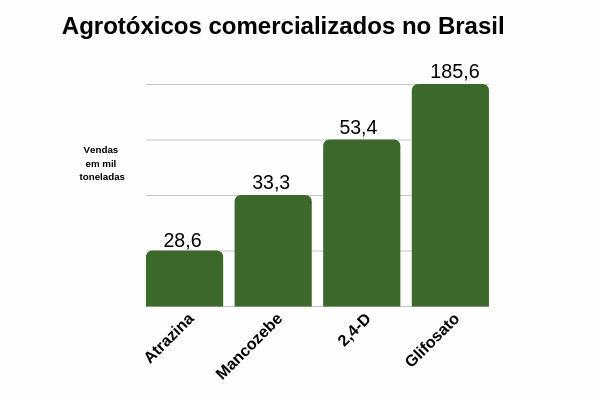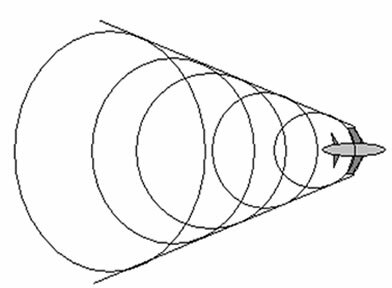Pesticides are, according to the Ministry of Agriculture, Livestock and Supply, chemical, physical or biological products used in the sectors of Agricultural production, pastures, among others, with the objective of changing the chemical composition of both the flora how much of the fauna in order to preserve them. The use is associated with environmental and health problems, according to surveys carried out by bodies such as the World Health Organization and the National Health Surveillance Agency. They are also known as pesticides, agrochemicals and pesticides.
Read too: Environmental contamination by pesticides
Types of pesticides
The types of pesticides are associated with nature of the plague which will be fought, the chemical group to which it belongs, as well as damage related to the environment and human health.
They are classified into:
Insecticides |
Fight insects. Examples: Aldrin, Carbofuran, Deltamethrin. |
Fungicides |
Fight fungi. Examples: Mancozeb, Binapacril, Brestam. |
Herbicides |
Fight weeds. Examples: Profam, Diquat, Dichlobenil. |
Defoliants |
Fight unwanted leaves. Examples: Paraquat and Dinoseb. |
Fumigants |
Fight bacteria in soil. Examples: Dazomet and Chloropicrin. |
Pesticides in agriculture

Pesticides are used quite frequently in agricultural production in order to increase productivity and combat pests.
Pesticides are widely used in agricultural production, especially in monocultures. This is because planting a single species provides favorable conditions for the existence of pests and diseases. But it is worth noting that the use of pesticides also occurs in smaller scale productions, as there is a need to use pesticides in order to break the pest cycle and reduce the risk of damage to the plantation to ensure increased productivity. However, the excessive and incorrect use of pesticides can cause serious damage to the environment, as contamination of the soil, groundwater, cultivated products and, consequently, causing damage to human health.
The champion agricultural productions in the use of pesticides were, according to the National Union of Vegetal Defense Products Industry (Sindiveg), in 2017:
1º Soy
2nd Sugarcane
3º Corn
4th Cotton
read more: Importance of Brazilian agriculture
Toxicological classification of pesticides

Pesticides in Brazil receive on their label a toxicological classification, that is, they describe the potential risk of crop protection products to human health. This classification is done through color differentiation and also through the lethality dose of each. The National Health Surveillance Agency (Anvisa) classifies them into four classes:
1) Extremely toxic, indicated by Red color.
2) highly toxic, indicated by yellow color.
3) moderately toxic, indicated by blue color.
4) Low toxic, indicated by green color.
Pesticides in food

According to Anvisa, many foods that are part of the Brazilian diet have a high concentration of pesticides.
The level of pesticides present in food has increasingly concerned society and organizations that take a stand against the use of these pesticides. Anvisa, through the Program for the Analysis of Pesticide Residues in Food (PARA), released a survey, carried out between 2013 and 2015, which evaluated more than 12 thousand food samples.
The risk presented by the research refers to the intoxications which can occur within a period of 24 hours after consumption of the food. The choice of foods for the research was carried out according to their representation in the diet of Brazilians.
See below for the list of foods with the greatest potential for risk due to the use of pesticides:
- Orange: out of 744 samples, 90 had acute risk potential.
- Pineapple: of 240 samples, 12 had potential for acute risk.
- Cabbage: from 228 samples, 6 presented potential acute risk.
- Grape: of 224 samples, 5 presented potential acute risk.
According to the report, although most irregularities pointed out do not point to damage to consumer health, so In general, the concern for the health of the farmer is shown if by chance he uses pesticides without following the correct recommendations of use.
Another report also released by Anvisa, but in 2010, showed the foods with the highest concentration of pesticides. 2,488 samples were used. O Bell pepper it is the product with the highest concentration of pesticides, followed by strawberries, grapes and carrots.
know more: What are healthy foods?
Pesticides can be found in food of plant and animal origin, like milk, eggs and meat. The alternative to avoid poisoning according to Anvisa is to reduce the intake of products grown with the use of pesticides and prefer organic products, that is, those whose cultivation does not use pesticides, as well as washing them correctly before consuming and, if preferable, removing the husks.
Pesticides in Brazil
Brazil is considered one of the greatest powers in the agricultural sector in the world. At the same time, the country is also at the top when it comes to the sale of pesticides. According to Revista Pesquisa Fapesp, the sale of pesticides in Brazil moves around US$ 10 billion per year.
There was also an expressive increase in use between 2010 and 2017. In 2017, around 540 thousand tons of agrochemicals were used in Brazil, approximately 50% more than in 2010 according to information released by the Brazilian Institute for the Environment and Renewable Natural Resources (Ibama). But it is worth noting that despite the large pesticide trade in the country, its use per hectare is low compared to other countries, being possible to affirm that the productivity of Brazil is high and the use of pesticides per produced area becomes low.
It is possible to say that the use of pesticides in Brazil is mainly related to factorsclimatic, since the country has a tropical climate in most of its territory. Thus, there are no winter periods (low temperatures) in some regions, favoring the cycle of pests and diseases.
Another relevant factor linked to the use of pesticides is the issue of technological evolution occurred in the field. The instruments currently used in the agricultural sector favored the increase in productivity and this requires greater control of possible damage to a crop. The practice of monoculture also favors the use of pesticides, as it also favors the cycle of pests and diseases.
It is worth noting that the use of pesticides in Brazil is regulated by a law - Pesticides Law nº 7.8022, of 1989 - therefore, there are restrictions to whoever uses it. However, this law was revoked in 2018 by a bill approved in the Chamber by Deputy Luiz Nishimori. The project provides for the release of certain pesticides by the Ministry of Agriculture, not making it clear what the power of action of bodies such as IBAMA and Anvisa is. It can be said then that the changes in the law, in a way, began to make the rules for the production, marketing and distribution of pesticides more flexible.
In early 2019, the Ministry of Agriculture approved the registration of pesticides from high toxicity. About 450 pesticides were registered in Brazil. Of these, only 52 have low toxicity. Anvisa stated that banned pesticides in countries such as China, the United States and countries of the European Union, they currently have Brazil as their main destination. Here at least ten products banned in these countries are used.
See what are the main pesticides sold in Brazil in 2016, according to data from Ibama:

That Flexibilization around the use of pesticides was and is the subject of several debates between environmentalists and several agencies that criticize the Brazilian government's permissiveness in relation to the use of pesticides. On the other side are the ruralists, who believe the use of pesticides is inevitable, since Brazilian productivity in the agricultural production sector depends on the use of these substances.
Advantages and disadvantages of using pesticides
Benefits |
Disadvantages |
The use of pesticides in recommended doses ensures the control of possible pests and diseases that can affect agricultural production. |
The use of pesticides is questioned by several health agencies, as it is associated with health problems such as chromosomal alterations, cancer of various types, respiratory diseases, among others. |
Controlling diseases and pests increases crop productivity and improves the visual quality of cultivated products. |
Using pesticides incorrectly causes environmental damage, such as contamination of soil and water resources. |
Usually the prices of products cultivated with the use of pesticides are reduced in relation to the price of organic products. |
Doses above the permitted can contaminate food and pose health risks. |
Also know: The importance of food in fighting cancer
What are pesticide residues?
Pesticide residues relate to the presence of agrochemicals, whether in vegetables or in the soil. It is, basically, the high concentration or not of pesticides, which, when applied to crops, for example, remain in food and the environment..
According to the Brazilian Association of Public Health, ingesting pesticide residues may be related to development of various diseases, such as cancer, endocrine and neurological disorders, which can manifest in the short or long term.
Read too: food contamination
The Maximum Residue Limit allowed in food is regulated by Law No. 7,802 of July 1989. The MRL refers to the allowed amount of pesticides in food from its production to consumption. The maximum amount allowed that does not pose health risks even if ingested daily for life is expressed in the as follows, according to the State Health Department of Paraná through the Chemical Waste Sector in foods:
Milligram of pesticide per kilogram of body weight - mg/kg b.w. |
By Rafaela Sousa
Graduated in Geography

